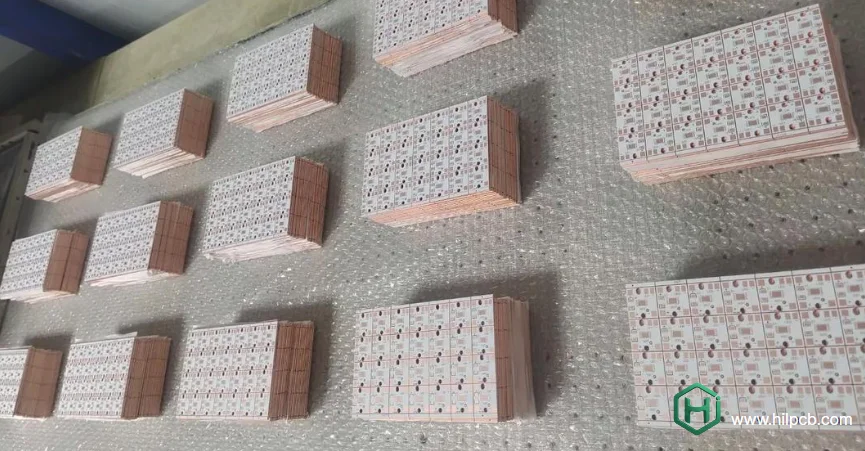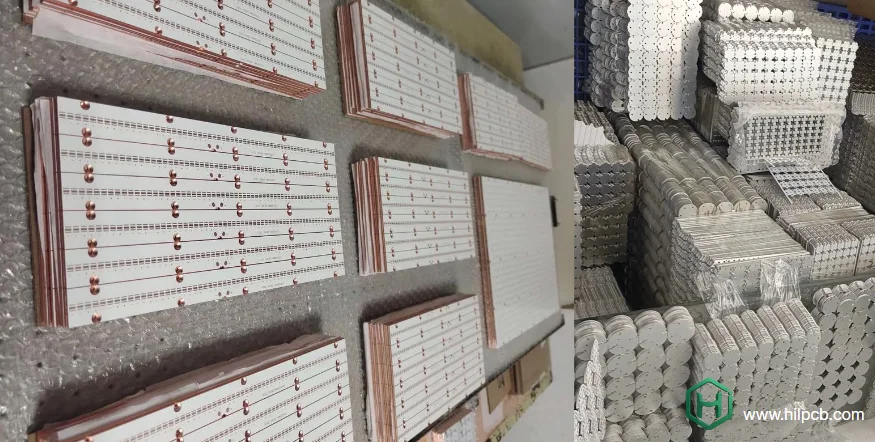High thermal aluminum PCBs are essential in power electronics, automotive lighting, renewable energy systems, and industrial automation — wherever efficient heat dissipation and electrical reliability are critical. Choosing the right high thermal aluminum PCB supplier ensures not only superior thermal conductivity and mechanical strength but also consistency across large production runs.
A professional supplier integrates material selection, thermal simulation, precision drilling, and surface finishing into a unified process, guaranteeing optimal heat transfer and long-term stability. With end-to-end manufacturing control, they deliver boards that maintain performance under high current and temperature stress, meeting the demands of LED lighting, EV chargers, power modules, telecom systems, and other high-power applications.
What Defines High Thermal Aluminum PCB Technology
High thermal PCBs use specialized dielectric formulations designed to enhance heat transfer while maintaining high electrical insulation. Standard aluminum PCBs rely on epoxy-based dielectrics (1.0–2.0 W/mK), while high thermal boards employ ceramic-filled compounds such as aluminum oxide (Al₂O₃), aluminum nitride (AlN), or boron nitride (BN), achieving up to 8.0 W/mK conductivity.
Key performance factors include:
- Thermal Conductivity (W/mK): Determines how efficiently heat flows through the dielectric.
- Dielectric Thickness: Thinner layers reduce resistance but lower breakdown voltage.
- Thermal Resistance (°C/W): Measures real heat transfer efficiency between component and base.
- Mechanical Stability: Ensures handling reliability during SMT assembly or reflow processes.
A well-engineered high thermal aluminum PCB maintains insulation >3000V, thermal resistance <1.0°C/W, and dimensional stability across wide temperature ranges.
Material Grades and Thermal Performance Tiers
Suppliers classify materials into several performance tiers, balancing cost, conductivity, and mechanical robustness.
| Material Tier | Thermal Conductivity | Typical Applications |
|---|---|---|
| Standard (1–2 W/mK) | General-purpose LED, consumer devices | Similar to single and double-layer PCBs but enhanced for moderate heat |
| Mid-Range (2–4 W/mK) | Automotive lighting, telecom amplifiers | Balanced cost and heat performance |
| Premium (4–6 W/mK) | High-power LEDs, motor drives | Incorporates AlN fillers for superior conductivity |
| Ultra-High (6–8+ W/mK) | Aerospace, high-power lasers, defense | Extreme heat loads, premium pricing justified |
Material choice depends on power density, ambient conditions, and lifespan requirements.
How to Evaluate a High Thermal Aluminum PCB Supplier
Selecting a capable supplier goes beyond checking datasheets — it’s about verifying real-world performance and process control.
• Material and Process Expertise
Experienced suppliers offer a full portfolio of aluminum, copper, and hybrid metal-core PCB materials, maintaining partnerships with global brands like Bergquist or Denka. Key criteria include:
- Vacuum lamination for void-free dielectric bonding.
- Precise curing temperature control for uniform thickness.
- Proven experience with 5.0+ W/mK materials.
• Thermal Testing Capabilities
Professional suppliers conduct:
- ASTM D5470 and ISO 22007 thermal conductivity testing.
- Junction-to-case resistance verification using calibrated sensors.
- Infrared imaging to visualize heat spreading.
These validation methods ensure performance matches design expectations.
• Quality and Certification
Reputable suppliers maintain ISO 9001, IATF 16949, and UL certifications, along with RoHS and REACH compliance.
Such systems guarantee repeatable quality comparable to high-frequency PCBs used in critical RF applications.
• Engineering Collaboration
Leading manufacturers offer DFM optimization, thermal via placement consulting, and simulation support to refine layouts before production. This collaboration reduces risk and accelerates time to market.

Design Techniques for Superior Thermal Efficiency
Thermal performance is not just about materials—it’s also about intelligent design. Optimal layouts can cut operating temperatures by 15–25°C compared to unoptimized designs.
Key Strategies:
- Thermal Vias: Clustered under heat-generating components to channel heat efficiently to the aluminum base.
- Copper Weight Optimization: Using 2–10 oz copper planes where current or heat density is high.
- Component Placement: Position power devices near heat sinks or board edges for better convection.
- Interface Control: Apply consistent thermal interface materials (TIM) during turnkey assembly for uniform contact pressure.
Suppliers providing simulation assistance can verify heat flow before physical prototyping, minimizing costly redesigns.
Application Areas for High Thermal Aluminum PCBs
High thermal PCBs serve industries where temperature directly affects reliability and performance.
- LED Lighting: Stable junction temperatures extend LED lifespan and preserve color accuracy.
- Automotive Systems: Under-hood modules, headlamps, and power management benefit from 5–8 W/mK materials with IATF 16949 traceability.
- Power Conversion: Drives, chargers, and inverters rely on HDI PCB integration for compact, high-efficiency layouts.
- Industrial Equipment: Ruggedized designs withstand thermal cycling and vibration, often combined with box-build assembly for complete product integration.
Testing and Validation for Thermal Reliability
Comprehensive testing confirms that PCBs meet both design and regulatory standards:
- Thermal Conductivity Verification: ASTM or ISO test methods ensure consistent material quality.
- Thermal Resistance Measurement: Simulated heat loads quantify junction-to-base transfer efficiency.
- Electrical Insulation Testing: Hi-pot and insulation resistance tests confirm safety compliance.
- Reliability Validation: Thermal cycling (-40°C to +125°C), humidity exposure, and mechanical shock testing guarantee long-term durability.
Professional suppliers provide complete reports with measured data, helping engineers correlate simulation with actual performance.
Conclusion
As power densities rise, high thermal aluminum PCBs are no longer optional — they are essential to product success. Choosing the right supplier ensures you get materials, process precision, and thermal validation that directly translate to reliability and longevity.
HILPCB delivers fully validated high thermal aluminum PCB solutions, from 1.0 to 8.0 W/mK conductivity, backed by advanced manufacturing, quality systems, and integrated assembly services. Whether for high-power LED arrays, automotive modules, or industrial control systems, our expertise transforms heat management into a lasting performance advantage.

